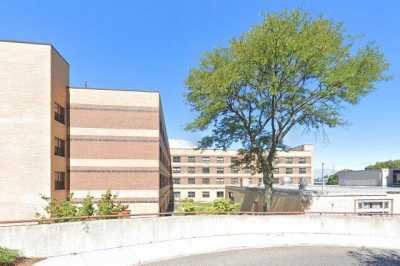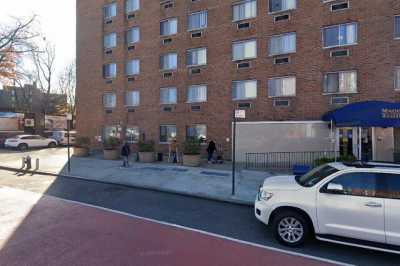
10 Best Nursing Homes in Queens, NY
By far New York City’s largest borough by land area, Queens is sandwiched between Brooklyn to the south and Nassau County of Long Island to the east, and it’s connected to Manhattan by the Queensboro Bridge. Queens boasts several iconic landmarks, including Flushing Meadows Corona Park, home of the New York Mets, the US Open tennis event, and two World’s Fairs.
Second to Brooklyn in population size but with highest number of adults 65 and older, Queens is known for its diversity and the many spoken languages that come with it. Naturally, this borough also offers a variety of senior living options.
While many people use the term nursing home as a catchall for senior living facilities, nursing homes are distinct, providing 24/7 medical care for individuals living with a disability or chronic condition. Because of the intensive medical care that nursing homes provide, costs are the highest among all senior care options. For instance, the starting cost for a shared room in a nursing home is $12,471 in New York City. Keep in mind, however, that individuals without chronic and severe medical care needs don’t require a nursing home level of care.
A Place for Mom doesn’t partner with nursing homes, but we do partner with general assisted living facilities, such as assisted living and memory care, for residents without severe conditions. These senior care facilities still offer several care services to support seniors with a variety of needs. Additionally, 100% of our partner assisted living and memory care communities offer part-time nursing care services.
Assisted living in Queens costs an average of $6,319 per month. Memory care, a senior living option with added features catering to individuals living with dementia, is slightly more expensive at $6,710 per month, according to A Place for Mom’s proprietary data.
Nursing Homes Facilities near Queens, NY
Very professional they too great care of my friends staff very friendly and the social workers did a really great job explaining everything to me I would recommend it to anyone
I would like to start off by saying I took a chance sending my dad here for rehab. I read the reviews and I was quite hesitant to say the least. However, from the moment my dad arrived to today (the day he...
My mother was in Providence Rest on 4 different occasions, longest stay bring over 3 months. Each time she had gone there for rehab after hospital stays. She received excellent care & rehab. The majority of...
My father was at the facility for knee rehabilitation for 1 week. The place is under new management and completely renovated. Starting from admissions to therapists the place deserves a 5 star rating. Very...
I moved my wife into 80th Street in January 2020. Several months later 80th Street went into lockdown following the Department of Health's mandates. While I was unable to see her in person, there was regular...
Our free advisors can help
- Compare local facilities
- Determine care type
- Schedule tours
- Evaluate pricing
Our methodology
How we rank order the Queens community options above
We developed a proprietary recommendation system that orders Queens community options based on factors we know are important to seniors and their families:
- Proximity to your search location
- Availability of recent, high-quality reviews
- The amount of detailed community information available
Where we source our information
14,000+ communities
We collect proprietary data from our network of 14,000+ senior living communities in the U.S., with regular refreshes of data and information
350,000+ reviews
We have 387,000+ reviews from senior living residents and family members that provide first-hand accounts about senior living communities
Cost of nursing homes in Queens
The median cost of a nursing home in Queens starts at $12,471.[01] This is based on the median cost of nursing homes in the New York City area, including the boroughs of Manhattan, Brooklyn, the Bronx, and Staten Island.
What’s included in the cost of nursing homes?
Nursing homes provide medical care for seniors who require round-the-clock supervision and skilled nursing care. This level of care is often recommended by an individual’s medical team. The monthly costs of a nursing home typically include the following:
- Skilled nursing which may include injections, wound care, and catheter care
- Occupational, physical, and speech therapies
- A private or semi-private room
- Three daily meals
- Administration and management of medication
Nursing homes provide a high level of medical care, which may not be necessary for all older adults. For seniors who would benefit from some assistance but don’t require 24/7 medical supervision, assisted living or memory care is a more suitable senior living option.
Cost of assisted living and memory care in Queens
Compared to nursing homes, assisted living and memory care facilities are typically less expensive. In Queens, the average costs for these senior care options, according to A Place for Mom’s proprietary data, are listed below:[02]
- Assisted living: $6,319
- Memory care: $6,710
Assisted living and memory care costs in Queens are less expensive than all neighboring boroughs except for Brooklyn.
The cost of assisted living and memory care facilities typically includes personal care services such as assistance with daily hygiene, dressing, and mobility. Memory care facilities are a specialized type of assisted living that offers additional security and supervision for the safety of seniors who show symptoms related to Alzheimer’s or other types of dementia. It’s common for the following services and amenities to be included in the cost of an assisted living or memory care facility:
- Maintenance-free private or shared apartment
- Housekeeping and laundry
- Dining services
- Planned activities such as exercise classes, games, and social events
- Indoor and outdoor common areas
- Internet access
The actual cost of assisted living and memory care depends on several factors. An individual’s care needs will often have the greatest effect on overall costs, but location, apartment or room size, and upgraded amenities can also affect the cost.
How to pay for nursing homes in Queens
Families usually pay for nursing homes using a combination of private funds and assistance from public health care programs or military service benefits.
Private pay options for nursing homes in Queens
Paying for senior care with private funds whether your loved one lives in a nursing home, assisted living facility, or memory care facility often includes using income from a pension or retirement savings. Some seniors may decide to sell their home or take out a reverse mortgage to pay for nursing home or senior living costs.
Other common private funds families use to pay for senior care may include the following:
- Using benefits from a long-term care insurance
- Borrowing from a life insurance policy
- Applying funds from a health savings accounts (HSA)
Public health insurance and VA benefits can also provide some financial support for a loved one’s care. For more information on paying for senior care, you can review the payment section of our greater New York City nursing home page. Families navigating care options for their loved one will also find useful payment information in our guide to paying for long-term care.
Details on Medicaid, Medicare, and VA benefits are covered in the following sections.
Using VA benefits to pay for nursing home costs in Queens
If your loved one served in the United States military, they’re not alone in Queens. The borough is home to over 31,000 veterans, and 58% are 65 or older.[03] For veterans or their surviving spouses in need of long-term care, VA benefits offer several resources to help pay for senior care and living costs. These benefits typically extend to qualified veterans and their surviving spouses living in nursing homes, assisted living facilities, and memory care facilities.
Applying for benefits can be a complicated process, and sometimes a mistake or missed deadline can lead to delays or a denial of a benefits. Benefits counseling through veterans service organizations (VSOs) can help seniors and their spouses apply and file claims for VA benefits. Many local, state, and national VSOs are housed at the Queens office of the NYC Department of Veterans Services.
New York City Department of Veterans Services
Queens Borough Hall
120-55 Queens Blvd.
Kew Gardens, NY 11423
Phone: 718-286-3000
Monday – Thursday, 10 a.m. – 4 p.m.
Using Medicare to pay for nursing home costs in Queens
Seniors 65 and older are eligible for Medicare, a federal health insurance specifically for seniors and some individuals living with disabilities. Medicare doesn’t cover long-term room and board expenses at a nursing home, but it will cover doctor-directed costs in skilled nursing facilities on a temporary basis for seniors recovering from an injury or illness.
While Medicare doesn’t cover long-term room and board fees in assisted living or memory care facilities, it will pay for certain medical care and services regardless of where a senior lives. You can use the Medicare coverage tool to determine which of your care services Medicare will pay for.
Examples of Medicare-covered services may include the following:
- Hospital care (inpatient and outpatient)
- Doctor-prescribed home health care
- Doctor visits
- Prescription medications
- Hospice care
Most seniors already receiving Social Security benefits will be automatically enrolled in Medicaid. For those who aren’t, they can enroll online or visit their nearest Social Security Administration office.
For New York seniors who qualify, there are several Medicare Savings Programs to help them pay for Medicaid premiums, coinsurance, and deductibles. Additional information on these programs can be found on our New York City nursing home page.
Using Medicaid to pay for nursing home costs in Queens
Medicaid provides health insurance for people with low-incomes and individuals with disabilities. New York Medicaid, as it’s simply named, is administered by the state but funded cooperatively with the federal government.
New York Medicaid may cover nursing home care and room and board for Queens seniors who meet income, age, and care requirements. It can help Queens residents pay for the following types of care in a Medicaid-certified nursing home:[04]
- Long-term care at a skilled nursing facility
- Rehabilitation services related to a disability, injury, or illness
- Skilled nursing and other related medical care
For seniors who don’t require nursing home care, Medicaid can help them pay for certain care costs at assisted living and memory care facilities. The New York Assisted Living Program (ALP) is designed to help eligible seniors pay for care services in an assisted living facility, including:[05]
- Room and board at Medicaid-certified assisted living facilities
- Assistance with activities of daily living (ADLs) like bathing, grooming, and hygiene
- Housekeeping and laundry
- Intermittent nursing services
- Case management
- Medical supplies and equipment
- Specialized therapy such as physical, occupational, and speech therapies
The following resource list includes Medicaid offices in Queens where seniors can receive information and apply for Medicaid benefits in person. The Queens Community Medicaid Office employs Certified Application Counselors (CACs) who can help guide seniors through the application process. The department of health lists several ways for seniors to apply for Medicaid in New York.
Queens Community Medicaid Office
32-20 Northern Blvd., 3rd Floor
Queens, NY 11101
Phone: 718-784-6729
Monday – Friday, 8 a.m. – 5 p.m.
Jamaica Community Medicaid Office
165-08 88th Ave., 8th Floor
Jamaica, NY 11432
Phone: 929-252-3193
Monday – Friday, 9 a.m. – 5 p.m.
Far Rockaway Medicaid Office
219 Beach 59th St., 2nd Floor
Far Rockaway, NY 11693
Phone: 719-634-6910
Monday – Friday, 9 a.m. – 5 p.m.
What to expect from nursing homes in Queens
Queens expands from the Atlantic Ocean to the East River and has everything from quaint beach communities to densely populated urban neighborhoods. In addition to the varied geography, Queens is also shaped by the diversity of its residents: Nearly 47% of Queens’ residents were born outside of the United States.[06]
Nursing homes in Queens are often defined by where they’re located. In less populated areas of the borough, nursing homes may occupy a small campus surrounded by lawns and walking paths. Closer to Manhattan, where the population densities are higher, nursing home facilities are often in multistory buildings.
Nursing homes are regulated by the state of New York and typically offer the following care services and amenities regardless of where they’re located:
- Skilled nursing and specialized therapies or other specialized medical care
- Round-the-clock medical care and supervision
- Medical equipment and support for individuals with limited mobility
- Regular community activities for socialization
- Medication administration
- Private or semi-private room
- Meals
Assisted living and memory care
A Place for Mom doesn’t refer to skilled nursing homes, but we do partner with an array of assisted living and memory care communities (also known as adult care homes) in Queens. These senior care communities or adult care homes provide robust care services along with amenities and activities for seniors who are more independent and social.
Staff at our partnering Queens assisted living and memory care facilities aim to support the emotional and physical well-being of all residents. So, there are a variety of planned on-site activities for residents to participate in, such as clubs, social events, and entertainment. Some specific on-site activities common to our senior care partners in Queens include the following:
- Outdoor games such as shuffle board and bocce ball
- Swimming pools and gyms
- Cooking classes
- Qi gong and chair yoga classes
- Trivia and games
- Choir group
- Gardening club
- Wii bowling
- Dancing groups and classes
- Happy hours and holiday celebrations
Many communities also offer access to comfortable building amenities. For example, on-site beauty salons and barbershops can provide trims or full-on stylings. Outdoor common areas offer space for relaxing and enjoying the summer sun. Theater rooms are a great spot to gather with friends to watch the newest releases or classic favorites. You can expect many of our partnering adult care communities in Queens to also offer the following:[02]
- Staff fluent in a variety of languages, including German, Korean, and Mandarin
- Swimming pool or jacuzzi
- Billiards lounge
- Central fireplace
- Computer or media center
- Restaurant-style dining room
Our partnering Queens memory care facilities offer many of the same types of services and amenities as above but with additional dementia care supports, including:[02]
- Specially trained memory care staff
- Reminiscence therapies, sensory activities, and other dementia-focused programs
- Specially designed building layouts to support the safety and emotional needs of residents living with Alzheimer’s and other types of dementia
Activities for seniors in Queens
The unique patchwork of neighborhoods that make up Queens celebrate a vastness of ethnic and cultural diversity. This distinctive melting pot offers seniors and their families a supermarket cereal aisle of activity choices across the borough. These include indoor and outdoor senior-friendly activities, community celebrations, and mouth-watering food options.
You can find food from all over the world in Queens, along with several old favorites. The Jackson Heights neighborhood is home to Little India and a variety of restaurants that highlight India’s varied cuisine. Flushing offers Queens’ version of Chinatown, which many say rival its Manhattan sibling. There are numerous Asian bakeries and restaurants in Flushing, with everything from sweet cakes to dumpling soups.
Queens offers plenty of things to do and places to see, like these other local favorites:
- Wind your way through the historic tree grove on the wheelchair-accessible paths in Kissena Park.
- The large Flushing Meadows Corona Park offers visitors a look at historic remnants of the 1964 World’s Fair, such as the iconic Unisphere.
- The Socrates Sculpture Park rests along the East River and displays a wild array of rotating works by international artists.
- The Museum of the Moving Image leads visitors through the history of film, television, and digital media.
How do seniors in Queens get around?
Many residents in Queens favor public transportation over personal vehicles to navigate the city. However, relying on a bus or the subway to get around can be a challenge for some seniors. That’s why over 83% of our partner assisted living and memory care communities in Queens offer transportation services to residents. This convenient service helps seniors get to doctor’s appointments, run errands, and attend social events.[02]
Additionally, New York City Transit operates paratransit services, which are for individuals with disabilities that prevent them from using other modes of public transportation. All of New York City’s buses have ramps or wheelchair lifts in accordance with the Americans with Disabilities Act (ADA), but only 27% of the city’s subway stations are ADA compliant. This can create obstacles for seniors living with mobility limitations.[07]
Seniors 65+ can apply for a Reduced-Fare MetroCard to receive discounted transportation on public transportation. You can also learn more about senior transportation options in Queens on the NYC 311 website.
Health care for seniors living in Queens
Access to quality health care options nearby offers peace of mind for families with aging loved ones. The following hospitals in Queens received high ratings for care specialties, procedures, and treatment of specific conditions:
- New York Presbyterian Queens Hospital. A general medical and surgical facility, this hospital is highly ranked for the treatment of certain cancers, including leukemia, colon cancer, and myeloma. It also provides high level care for people experiencing heart attacks and kidney failure.[08]
- Jamaica Hospital Medical Center. Recognized for its high performing stroke center, this hospital also provides geriatric care for seniors and a variety of other medical care to Queens residents.[08]
Senior living facility laws and regulations in Queens
Nursing homes are regulated and licensed by the New York State Department of Health (NYSDOH). To operate, nursing home and senior care facilities must be certified and routinely inspected. The state department works to ensure facilities follow regulations that require them to maintain quality of care and safety for all residents.
New York senior care home licensing specifics
Assisted living and memory care facilities are licensed as adult care homes in NYC and are different from facilities with the nursing home license. Adult care homes maintain a different license because they require less medical specialization than nursing homes do. Nonetheless, the New York State Department of Health inspects all senior care facilities annually and keeps records on both licensed nursing homes and adult care homes in the area.
Inspection reports for nursing homes in Queens
Inspection reports for nursing homes and adult care home (assisted living) facilities are available for review using the New York State Department of Health’s Health Profiles portal. With this portal, you can find information regarding a care facility’s citations and corrective actions. To navigate the search, follow these steps:
- From the home page, enter the name of a facility in the “Find a Provider Name” box.
- If you don’t know the name, choose the facility type (Nursing Homes or Adult Care Homes) from the tabs at the top of the page.
- From the facility type drop-down menu, click on “Search by Region/County.”
- From the “Region/County” drop-down menu, find “Queens” and click on it. A list of facilities will populate.
- Click on the name of the facility you’d like to view.
- Then click on the “Inspections” button above the facility name.
- Click on the citations or enforcement buttons to review detailed information.
You can also search by using the interactive map on the right side of the Health Profiles portal home page. You can enter either a facility name or “Queens” into the “Search for Zip, County, Name” search bar. The map will zoom in to the area’s licensed facilities, which you can click on for more information.
Our greater New York City nursing home page covers more information on New York’s laws and regulations for nursing homes.
Frequently Asked Questions
Split Rock Nursing Home, Arden Courts A ProMedica Memory Care Community in West Orange and Ditmas Park Care Ctr are the top-rated Nursing Homes facilities near Queens, NY. These Nursing Homes facilities received the highest rankings based on verified family reviews. See full list of communities.
The average cost of Nursing Homes in Queens is $9,314 per month. This cost may vary based on location, amenities, floorplan, level of care and other factors.
References
Genworth. (2021). Cost of Care Survey.
A Place for Mom. (2023). A Place for Mom proprietary data.
United States Census Bureau. (2021). Veteran status (S2101). [Data set]. American Community Survey.
Centers for Medicare and Medicaid Services. Nursing facilities.
New York State Department of Health. (2014, August). Assisted Living Program.
United States Census Bureau. (2022, July 21). Population estimates July 1, 2022 (VO2022). [Data set]. Quick Facts: Queens County, New York.
Elkeurti, A., & Ley, A. (2023, August 1). Elevators at most subway stations? I’ll believe it when I see it. The New York Times.
U.S. News and World Report. (2023). Hospitals in Queens, NY.

More questions?
Ask an A Place for Mom local advisor at no cost.
- Manhattan, New York
- Edgewater, New Jersey
- Cliffside Park, New Jersey
- Fairview, New Jersey
- Brooklyn Manor, New York
- Guttenberg, New Jersey
- Ridgefield, New Jersey
- Leonia, New Jersey
- Ridgefield Park, New Jersey
- Little Ferry, New Jersey
- Englewood Cliffs, New Jersey
- Bronx, New York
- Englewood, New Jersey
- South Hackensack, New Jersey
- West Englewood, New Jersey
- Bergenfield, New Jersey
- Teaneck, New Jersey
- Moonachie, New Jersey
- Teterboro, New Jersey
- North Bergen, New Jersey
























